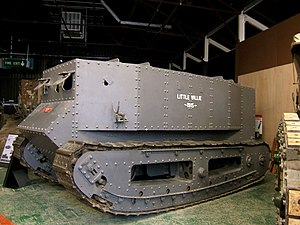Little Willie
| Little Willie | |
|---|---|
|
Little Willie at the Tank Museum, Bovington (2006)
|
|
| Type | Prototype tank |
| Place of origin | United Kingdom |
| Production history | |
| Designed | July 1915 |
| Manufacturer | Fosters of Lincoln |
| Produced | August–September 1915 |
| No. built | 1 |
| Specifications | |
| Weight | 16.5 tonnes |
| Length |
19 ft 3 in (5.87 m) 26 ft 6 in (8.08 m) inc. rear steering wheels |
| Width | 9 ft 5 in (2.87 m) |
| Height |
8 ft 3 in (2.51 m) to top of hull 10 ft 2 in (3.10 m) to top of turret |
| Crew | (Projected) 6 |
|
|
|
|
Main
armament |
(Projected) Vickers 2-pounder gun |
|
Secondary
armament |
(Projected) Various suggestions of Maxim, Hotchkiss, Lewis, or Madsen machine guns |
| Engine | Foster-Daimler Knight sleeve valve petrol 105 hp (78 kW) |
| Power/weight | 6 hp/tonne |
| Transmission | Two-speed forwards, one reverse final drive by Renolds chains |
| Suspension | Unsprung |
| Speed | 2 mph (3.2 km/h) |
19 ft 3 in (5.87 m)
8 ft 3 in (2.51 m) to top of hull
Little Willie was a prototype in the development of the British Mark I tank. Constructed in the autumn of 1915 at the behest of the Landships Committee, it was the first completed tank prototype in history. Little Willie is the oldest surviving individual tank, preserved as one of the most famous pieces in the collection of The Tank Museum, Bovington, England.
Work on Little Willie's predecessor was begun in July 1915 by the Landships Committee to meet Great Britain's requirement in World War I for an armoured combat vehicle able to cross a 8-foot (2.4 m) trench. After several other projects with single and triple tracks had failed, on 22 July William Ashbee Tritton, director of the agricultural machinery company William Foster & Company of Lincoln, was given the contract to develop a "Tritton Machine" with two tracks. It had to make use of the track assemblies - lengthened tracks and suspension elements (seven road wheels instead of four) - purchased as fully built units from the Bullock Creeping Grip Tractor Company in Chicago.
On 11 August actual construction began; on 16 August Tritton decided to fit a wheeled tail to assist in steering. On 9 September the Number 1 Lincoln Machine, as the prototype was then known, made its first test run in the yard of the Wellington Foundry. It soon became clear that the track profiles were so flat that ground resistance during a turn was excessive. To solve this, the suspension was changed so that the bottom profile was more curved. Then the next problem showed up: when crossing a trench the track sagged and then would not fit the wheels again and jammed. The tracks were also not up to carrying the weight of the vehicle (about 16 tons). Tritton and Lieutenant Walter Gordon Wilson tried several types of alternative track design, including balatá belting and flat wire ropes. Tritton, on 22 September, devised a robust but outwardly crude system using pressed steel plates riveted to cast links and incorporated guides to engage on the inside of the track frame. The track frames as a whole were connected to the main body by large spindles. This system was unsprung, as the tracks were held firmly in place, able to move in only one plane. This was a successful design and was used on all First World War British tanks up to the Mark VIII, although it limited speed.
...
Wikipedia

